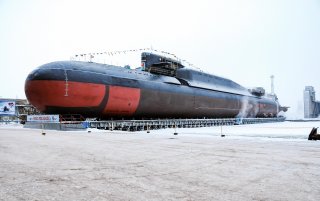Putin Slept In It: Meet Russia’s Delta-Class Block IV Ballistic Missile Submarine
And other strange facts about this submarine.
The Delta-class IV submarines have quite a few unique distinctions under their belts. For better or for worse, none of them are due to success in combat or even events of military importance. Here are the odd distinctions of Russia’s Delta-class Block IV submarines.
Presidents, Fires, and Satellite Launches
The K-18 Karelia, commissioned in 1989, hosted Interim Russian President Vladimir Putin in 2000. Putin witnessed exercises and slept abroad the sub. In keeping with mariner tradition, “the ritual of initiating Vladimir Putin into a submariner took place. In according to the ritual, the President drank some water from the sea, and then the certificate of honored submariner was issued to him.” Not a bad trade for drinking some salt water.
The K-407 Novomoskovsk has a formidable missile launch capability, with 16 missile silos onboard. In August 1991, the Novomoskovsk successfully launched an all-missile salvo, the largest all-missile launch ever, at 16.
This was the Novomoskovsk’s first attempt, after a botched 1989 attempt by sister ship K-84 Ekaterinburg, in which a leak inside one of the silos caused a fire, destroying the missile. The second, successful launch resulted in a nearly 700-ton launch. Though grainy, the actual video of the launch can be seen online.
The same submarine was involved in a collision off the Kola Peninsula with the U.S. nuclear attack submarine USS Grayling in 1993. Although both submarines sustained only light damage, the collision came at a politically sensitive time, as the first meeting between President Clinton and Boris Yeltsin was scheduled a week later.
Novomoskovsk is also reportedly the only submarine that has ever successfully been used as a launch platform for satellites. Perhaps an attempt to earn revenue for the cash-strapped armed forces, the Novomoskovsk launched two German microsatellites.
Submarine K-84 Ekaterinburg caught fire in late 2011 during routine maintenance in yet another incident involving the extremely unlucky PD-50 dry dock. Apparently sparking caused by wielding ignited wooden scaffolding on the sub’s hull, which caused flammable rubber matting covering the hull to also catch fire.
In order to put out the fire, the Ekaterinburg was partially sunk, extinguishing the blaze. Officially, American and Soviet/Russian submarines must unload their weapons when docked, but reports indicate that the Ekaterinburg may have actually been fully armed at the time of the fire.
Reuters, quoting a Russian magazine detailed the accident, saying “Russia, for a day, was on the brink of the biggest catastrophe since the time of Chernobyl,” referencing what is widely regarded as the world’s worst nuclear disaster. Russian officials insisted that there was no radiation leak, and that the submarine was unarmed, but a trip to a weapons depot immediately after the blaze could indicate otherwise. Video of the fierce blaze is available online.
Into the Horizon
Given the dearth of cash available to Russia’s armed forces, the Delta-Class Block IVs may not be retired for quite some time. Maybe a frightening prospect, considering the group’s shaky track record.
Caleb Larson is a Defense Writer with The National Interest. He holds a Master of Public Policy and covers U.S. and Russian security, European defense issues, and German politics and culture.

